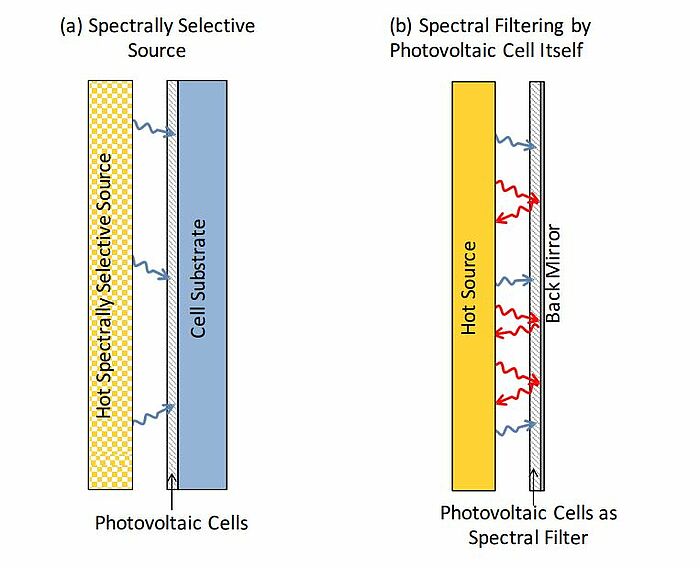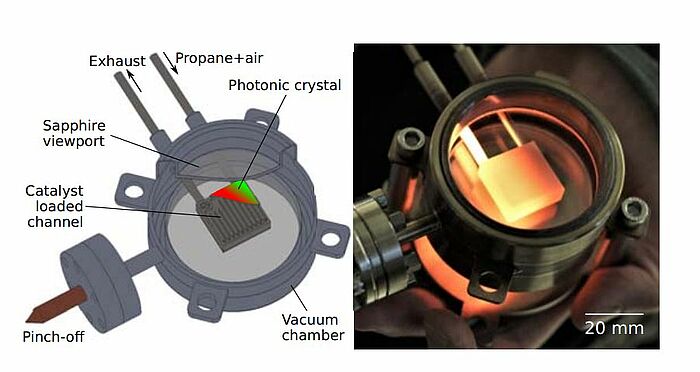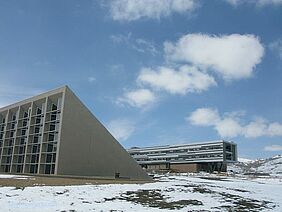When we read about photovoltaic cells, the first thing that comes to mind is seemingly endless rows of solar panels converting sunlight into electricity. However, energy cannot only be harnessed from sunlight, but also from hot objects which, unlike the sun, emit light at a longer wavelength and lower energy. In order to utilis e the energy contained within these objects, thermophotovoltaics (TPV) are used. They are usually made of absorber materials with bandgaps in the infrared range and can efficiently convert thermal radiation into electricity.
Thermophotovoltaic systems could play an important role in any renewable energy system with fluctuating energy sources. Excess electrical energy is stored as high-temperature heat, which can be converted again into electricity with the help of thermophotovoltaic modules. However, for the modules to work at optimum efficiency, smart photon management is essential: mirrors integrated into the TPV cells reflect the photons, which have energy levels that are too low to be used in the photovoltaic process, back to the heated emitter to be recycled. In this manner, higher system efficiencies are achieved.
Now (2022), scientists at the National Renewable Energy Laboratory (NREL) have developed a new photovoltaic cell which exceeds the 32% world-record efficiency for TPVs. The new device was constructed in collaboration with the Massachusetts Institute of Technology (MIT) for a joint demonstration of an electric-energy storage concept. The device was designed to harvest energy from an object heated to about 2,400°C and reached a maximum efficiencies of 41.1%. Its average efficiency amounted to 36.2% over a range of relevant temperatures.
The 41%-efficient TPV device consists of a tandem cell of III–V materials with bandgaps between 1.0 and 1.4 eV which are built out of two light-absorbing layers stacked on top of one other and tuned to absorb slightly different wavelengths of light and are optimised for emitter temperatures of 1,900–2,400 °C. Band-edge spectral filtering is used to obtain high efficiency. Two devices were tested: a 1.4/1.2 eV device reached a maximum efficiency of (41.1 ± 1)% operating at a power density of 2.39 W cm–2 and an emitter temperature of 2,400 °C, while a 1.2/1.0 eV device reached a maximum efficiency of (39.3 ± 1)% operating at a power density of 1.8 W cm–2 and an emitter temperature of 2,127 °C.
Image: Figure 1. Tandem TPVs: a, History of some TPV efficiencies12 with different cell materials: Ge39,40 (dark grey), Si10 (yellow), GaSb3 (light grey), InGaAs13,15,41,42,43 (dark blue), InGaAsSb44 (light blue) and GaAs14 (orange). The black line shows the average thermal efficiency of power generation in the United States using a steam turbine (coal and nuclear)36,37. Before the year 2000, turbine efficiencies shown also include natural gas. b, Energy that is incident on the TPVs (Pinc) can be converted to electricity (Pout), reflected back to the emitter (Pref) or thermalized because of inefficiencies in the cell and back reflector (Qc). c, d, The 1.2/1.0 eV (c) and 1.4/1.2 eV (d) tandems that were fabricated and characterized in this work, and a representative spectrum shape at the average emitter temperature (2,150 °C blackbody) indicating the spectral bands that can be converted to electricity by the top and bottom junction of a TPV cell. A gold mirror on the back of the cell reflects approximately 93% of the below bandgap photons, allowing this energy to be recycled. TJ represents the tunnel junction
Source: Alina LaPotin, Kevin L. Schulte, Myles A. Steiner, Kyle Buznitsky, Colin C. Kelsall, Daniel J. Friedman, Eric J. Tervo, Ryan M. France, Michelle R. Young, Andrew Rohskopf, Shomik Verma, Evelyn N. Wang & Asegun Henry/ Thermophotovoltaic efficiency of 40%/ Nature volume 604, pages 287–291 (2022), 13 April 2022/ doi.org/10.1038/s41586-022-04473-y/ Open Source This article is licensed under a Creative Commons Attribution 4.0 International (CC BY 4.0)
An additional feature which greatly contributed to the high efficiency of the design was a highly reflective gold mirror at the back of the cell. As the emitted infrared light has a longer wavelength than the active layers can absorb, the gold back surface reflector was needed to bounce the unabsorbed light back to the emitter to be reabsorbed and -emitted, which improved the efficiency of the system. The cells can be integrated into a TPV system for thermal energy grid storage to enable dispatchable renewable energy. This creates an opportunity to reach sufficiently high efficiency in thermal energy grid storage at low cost to enable decarbonisation of the electricity grid.
Scientists have long sought to design more efficient thermoelectric systems. In 2016, thin films of direct bandgap, which consisted of epitaxially grown semiconductors for thermophotovoltaics, were used to achieve high absorption of above-bandgap photons but low free carrier absorption. For this purpose, films of GaAs were grown on substrate, with the film separated from the substrate by a thin layer of aluminium arsenide (AlAs). The AlAs layer was then chemically etched, and the film was lifted off the substrate and placed on a reflective back mirror, which was a crucial procedure to achieve high back mirror reflectivity, because it allowed the substrate to be replaced by a back mirror. However, even though the GaAs photovoltaic cells had a high efficiency under sunlight, the bandgap of GaAs (1.4 eV) was too large to obtain high efficiency under cooler source temperatures of 1200°C to 1500°C which are needed for thermophotovoltaic systems. Therefore, with the same epitaxial lift-off process, the scientists designed direct-band in GaAs cells with smaller bandgaps and calculated the optimal bandgaps needed for thermophotovoltaics.
Image: Figure 2. For high efficiency, below bandgap photons need to be recycled back to the hot source. This is done with (a) a spectrally selective source, such as a photonic crystal, which exhibits low emissivity of below bandgap photons (low emissivity of photons is analogous to high reflectivity of photons back to the source) or (b) with a mirror on the back of the photovoltaic cells which reflects the infrared photons back to the source
Source: Vidya Ganapati, T. Patrick Xiao, Eli Yablonovitch/ Ultra-Efficient Thermophotovoltaics Exploiting Spectral Filtering by the Photovoltaic Band-Edge/ [physics.optics], Cornell University, 10 Nov 2016/ doi.org/10.48550/arXiv.1611.03544/ Open Source This article is licensed under a Creative Commons Attribution-NonCommercial-ShareAlike 4.0 International (CC BY-NC-SA 4.0)
In 2017, scientists designed a fully-integrated portable generator and modified a microcombustor for propane-air combustion using a propane-oxygen design they had previously created. Then they tested the vacuum package of the microcombustor, which was needed to preserve the photonic crystal, in a 50+ day experiment in which no degradation of vacuum level was witnessed. Finally, they vacuum packaged a microcombustor with integrated photonic crystals in a housing with two infrared-transparent windows to transfer the thermal radiation to external PV cells. Even if the scientists were not able to overcome all the problems in the experiment, this work demonstrated the feasibility of a mesoscale TPV system.
Image: Figure 3. Cutaway rendering and photograph of the vacuum packaged microcombustor with integrated photonic crystals in operation
Source: Walker R. Chan, Veronika Stelmakh, Sunny Karnani, Christopher M. Waits, Marin Soljacic, John D. Joannopoulos and Ivan Celanovic/ Towards a portable mesoscale thermophotovoltaic generator/ Journal of Physics: Conference Series, Volume 1052, 17th International Conference on Micro and Nanotechnology for Power Generation and Energy Conversion Applications (PowerMEMS 2017) 14–17 November 2017, Kanazawa, Japan, November 2017/ doi:10.1088/1742-6596/1052/1/012041/ Open Source This article is licensed under a Creative Commons Attribution 3.0 Unported (CC BY 3.0)
The new TVP system holds several advantages of conventionally-used ones: it can convert heat to electricity at greater efficiency than conventional steam turbines. It has the potential to lower costs, increase response times, is compatible with an extremely wide range of system sizes (from watts to gigawatts), and can reduce maintenance costs due to fewer moving parts. The new TPV cell is also suitable for operating with heat sources above 2,000°C, which are too hot for traditional steam turbines. It can also be included in thermal energy grid storage systems: they operate as a battery that takes in electricity and convert it to high-temperature heat for storage. TPVs can then convert that heat back to electricity when needed, providing low-cost, on-demand clean energy.
The TPV device created by the NREL scientists could be an important step forward in making clean energy storage less expensive and also scalable. It certainly offers a promising prospect with its improved energy capacities and flexibility.
